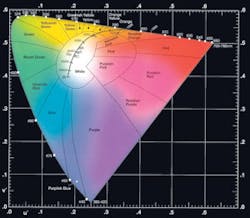What color is color?
“Color is the brain’s reaction to a specific visual stimulus,” says Alan Roberts, formerly of BBC Research (London, UK). “In the human visual system, signals from color-sensitive cells or cones, together with those from cells known as rods, which are sensitive to intensity, are combined in the brain to give several different sensations of color.” These sensations have been defined by the Commission Internationale de l’Eclairage (CIE; Vienna, Austria).
“Trichromatic theory describes the way RGB can match any visible color based on the eye’s use of three color-sensitive sensors,” says Roberts. “Color can be specified, created, and visualized using different color spaces. For human beings, a color can be defined by its attributes of brightness, hue, and colorfulness. Some color spaces are intuitive, and creating desired colors is relatively easy. Others are confusing with parameters that provide abstract relationships to the perceived color. Finally, some color spaces are tied to a specific piece of equipment (that is, they are device-dependent), while others are equally valid on whatever device they are used.
“The CIE’s set of tristimulus values called x, y, and z, which roughly correspond to RGB, are defined relative to RGB by a linear transformation,” says Larry Hubbard of the University of Wisconsin-Madison (Madison, WI, USA). “The CIE tristimulus values are the building blocks from which many color specifications such as RGB, HSV, and CMYK (cyan, magenta, yellow, and black ) are made. The x, y, and z, when normalized, become x, y, and z. These variables are chromaticity values that depend on the hue (H) and saturation (S) of the color.
“If two colors differ only in luminance, they have the same x, y, and z values. Because the sum of the x, y, and z components is 1, only two of the three values need to be expressed.” Since x, y chromaticity is nonuniform, the CIE defined a uniform chromaticity scale diagram (also known as the CIE 1976 UCS diagram) called the u´,v´ diagram (see figure).
“A computer can describe a color using the amounts of RGB required to match a color. A printing press can produce a specific color in terms of the reflectance and absorbance of cyan, magenta, yellow, and black inks on the printing paper. Color is usually specified using three coordinates, or parameters, that describe the position of the color within the color space being used.”
A device-dependent color space is one where the color produced depends on both the parameters used and the equipment used for display. Specifying the same RGB values on two different workstations will produce two different colors if viewed on side-by-side screens. Another test is to change the brightness and contrast settings (the offset and gain) on the display and see how a displayed color varies. A device-independent color space is one where a set of parameters will produce the same color on whatever equipment they are used.
RGB is an additive color system based on trichromatic theory and often found in systems that use a CRT to display images. RGB is easy to implement but is nonlinear with visual perception. It is device dependent and specification of colors is semi-intuitive.
HSL (lightness) represents a wealth of similar color spaces; alternative names include HSI (intensity) and HCI (chroma/colorfulness). Most of these color spaces are linear transforms from RGB and are therefore device-dependent and nonlinear. Their advantage lies in the extremely intuitive manner of specifying color. It is very easy to select a desired hue and to modify it slightly by adjustment of its saturation and intensity.
“The supposed separation of the luminance component from chrominance (color) information can have advantages in image-processing applications,” says Roberts. “However the exact conversion of RGB to HSL depends entirely on the equipment characteristics. Failure to understand this may account for the sheer numbers of related but different transforms of RGB to HSL, each claimed to be better for specific applications than the others.”
CMYK is a subtractive-based color space and mainly used in printing and hardcopy output. The fourth, black, component is included to improve both the density range and the available color gamut. CMYK is fairly easy to implement, but proper transfer from RGB to CMYK is difficult. CMYK is device-dependent, nonlinear with visual perception, and reasonably unintuitive.
YIQ, YUV, YCbCr, and YCC are television transmission color spaces, sometimes known as transmission primaries. YIQ (luma, in-phase, quadrature) and YUV (luma, and chroma difference signals) are analog spaces for NTSC and PAL systems, respectively, while YCbCr (luma and blue and red chrominance components) is a digital standard. These color spaces separate RGB into luminance and chrominance information and are useful in compression applications. These spaces are device-dependent but are intended for use under strictly defined conditions within closed systems. They are also quite unintuitive.
There are two CIE-based color spaces-CIELuv and CIELab-that are nearly linear with visual perception. Since they are based on the CIE color-measurement system, which is based on human vision, CIELab and CIELuv are device-independent but quite unintuitive, despite the L parameter having good correlation with perceived lightness. To make them more user friendly, the CIE defined two analogous spaces-CIELhs or CIELhc, where h is hue, s is saturation, and c is chroma. In addition, CIEluv has an associated 2-D chromaticity chart for showing additive color mixtures, making CIELuv useful in applications using CRT displays. CIELab has no associated 2-D chromaticity diagram and no correlate of saturation. CIELhs can not be defined.
null


